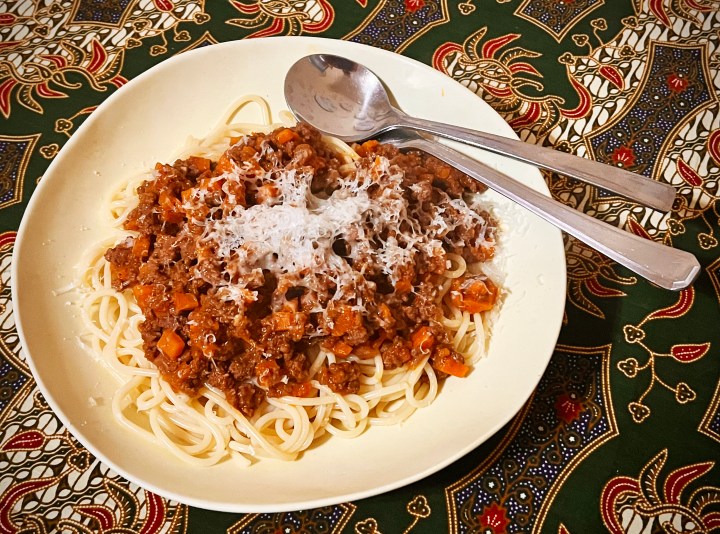WHAT’S IN A NAME?
Throwback Thursday: Spaghetti Bolognese

It’s the pasta dish that isn’t what it says it is. Well, it is, if you accept that it’s a bolognese sauce served with spaghetti, but as any resident of Bologna will tell you, they eat it with tagliatelle. And put wine in it. And milk. And they use no herbs in it. And anyway, it originated not in Bologna but in Imola, west of that city. But even that is not entirely accurate. Ja-nee.
Mention spaghetti bolognese and somebody in the vicinity is likely to say, well, of course you won’t find that in Italy – especially Italians. But is it entirely true to say spaghetti bolognese isn’t Italian, even if that precise name is not? The elements of which it is made are all as Italian as Parmesan and olive oil. They’re just not put together in a dish that can correctly answer to that name.
Another thing it’s not is spaghetti “bolognaise”, unless somehow Bologna has been disassembled and shifted by cargo train to France from Emilia-Romagna in northern Italy. Ragù alla Bolognese, often abbreviated simply to ragù, is a braise of beef mince with a soffritto of carrots, onions and celery, the Italian version of a French mirepoix. A ragù in Bologna (and of course Imola) is often served with tagliatelle, but other than the choice of pasta there’s not all that much to separate it from the spaghetti bolognese the rest of the world knows and loves, other than the heroic degree to which tomato features in the latter.
A ragù from Bologna has much less tomato, so Wikipedia’s assertion that spag bol is “more similar in fact to the ragù alla napoletana from the tomato-rich south of the country” is credible. In Naples in the sunnier south, tomatoes grow abundantly and turn rich and sweet at full ripeness, so their generous use in sauces is expected there.
Perhaps the best solution would be to ditch the spaghetti from both the recipe and the name, and call it Tagliatelle Bolognese. A ragù from Bologna, if not served with tagliatelle, would most likely be found with the broader pappardelle pasta or even lasagne. All of these forms of pasta are thought more suited to a ragù than the slim, round pasta strands we call spaghetti. Even the slightly thicker linguine might be preferred. In the end, then, the pity is that the name “spaghetti” became so firmly attached to a dish which is arguably improved without it, in favour of the aforementioned types of pasta. Pappardelle bolognese, anyone?
Is the popular ground beef sauce we serve with spaghetti really a ragù? Given that a ragù alla Bolognese contains white wine and milk, no; not technically at least. Is it Napoletana sauce? No, not that either, as the Napoletana way is to cut the beef very finely rather than mince it, and contains herbs, whereas a ragù does not.
However, spaghetti bolognese as we know it remains a thing, and will continue to thrive, if only because of how ubiquitous it is, so we might as well try to make it truly delicious and worthy of its (spurious) name.
Given that it is not going to be traditional no matter how you choose to cook it, I do take liberties. I sometimes use herbs such as oregano and thyme, also bay leaf, and I include red wine. Oh and there’s one more trick up my sleeve…
Ingredients
1 Tbsp olive oil
1 medium onion, chopped
2 large carrots, diced finely
1 celery stick, sliced thinly
2 cloves of garlic, chopped
1 kg lean beef mince
1 x 400 g can of Italian chopped tomatoes
100 ml tomato paste
1 litre of beef stock
1 glass/ 200 ml dry red wine
1 cup/ 250 g Parmesan and more to grate over the top
Salt and black pepper to taste
Method
Sauté the chopped onion, celery and carrot in olive oil with the garlic until softened, stirring often. Add the red wine and reduce by half.
Add the beef mince and work it with a wooden spoon so that it does not form clumps. Cook, stirring, until it has browned all over.
Add the tomatoes, tomato paste and beef stock, and cook on a very low heat, partly covered, for a good long while, adding a little more beef stock if needed to prevent it from drying out too much. Season with salt and pepper along the way and taste for balance of flavour.
The point of a ragù is long cooking, so aim to let it simmer away gently for about 45 minutes to develop as much flavour as you can. This alone is anathema to a Bolognese chef: two hours, more likely.
One more trick: Now, this may or may not be traditional, but it is what I do and I promise you, it improves a bolognese sauce, ragù, call it what you will, no end: Stir in a cup of finely grated Parmesan right before you serve, as well as grating more on top. That, for me, is what brings it all together. Oh, and serve it with spaghetti. Or tagliatelle. Or pappardelle. Or something. DM/TGIFood
Tony Jackman is Galliova Food Champion 2021. His book, foodSTUFF, is available in the DM Shop. Buy it here.
Mervyn Gers Ceramics supplies dinnerware for the styling of some TGIFood shoots. For more information, click here.
Follow Tony Jackman on Instagram @tony_jackman_cooks. Share your versions of his recipes with him on Instagram and he’ll see them and respond.
SUBSCRIBE to TGIFood here. Also visit the TGIFood platform, a repository of all of our food writing.






 Become an Insider
Become an Insider
Comments - Please login in order to comment.